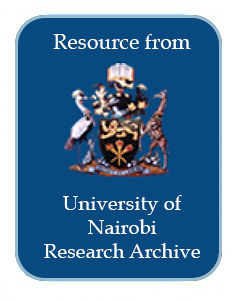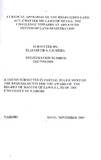Location
Our Vision is to be a world-class university committed to scholarly excellence.
Our Mission is to provide quality university education and training and to embody the aspirations of the Kenyan people and the global community through creation, preservation, integration, transmission and utilization of knowledge.
Core Values
In order to realize the above vision and mission, certain shared values shall be nurtured. There is great need for the University to be guided by the right values derived from the virtues and moral standards of the Kenyan and wider society.
Core Functions
Teaching and Learning: The university offers innovative , relevant and market driven academic programmes , both at undergraduate and postgraduate levels with inbuilt quality control systems the university also provides an environment and policy framework for undertaking high quality and relevant research
Members:
Resources
Displaying 146 - 150 of 298Effect of land use and soil fertility management practices on nematode destroying fungi in Taita, Kenya
The study was undertaken to investigate how land use and soil fertility management practices affect the occurrence of nematode destroying fungi. The aim of the study was to harness the potential of these fungi to control the plant parasitic nematodes in the study area which is a very important vegetable catchment in the Coast Province of Kenya
Land-Use Change and Livestock Production Challenges in an Integrated System: The Masai-Mara Ecosystem, Kenya
Participatory rural appraisal techniques and a survey of 100 households were used to evaluate livestock production, and pastoral development of the Maasai in Mara. It was observed that patterns of land-use have principally changed from nomadic pastoralism to sedentary pastoralism, agropastoralism, and, in some cases, pure cultivation. These trends have adversely affected livestock production and the productive capacity of the Mara ecosystem.
Web-Phone land information and billing System: Getting the Registry on your Mobile Phone
Survey of Kenya is the country's institution charged with the
responsibility of collecting, checking, storing and disseminating Land
parcel related records.
Of late efforts have been made to digitize these records and form a
database. However the majority of the records are in paper form.
Dissemination of this data, done through a search, is still manual. The
public fill a search form and pay a small fee, and the records are
reproduced to them in form of a filled and dully signed form or map or
A critical appraisal of the registered land act, chapter 300, Laws of Kenya: the challenge towards an advanced system of land registration
Community participation in the rehabilitation of a sand dune environment in Kenya
This study aims to document various community efforts in land rehabilitation and assess their potential. Data were captured using interviews and focus group with 150 community members. A public participation index was used to establish the extent of community efforts in land rehabilitation. The study revealed that in the absence of proper management and dune stabilisation, large areas covered with mobile sand dunes continue to be a threat to grazing lands in northern Kenya. In recognition of this threat, the people of North Horr have launched several initiatives to contain the problem.






